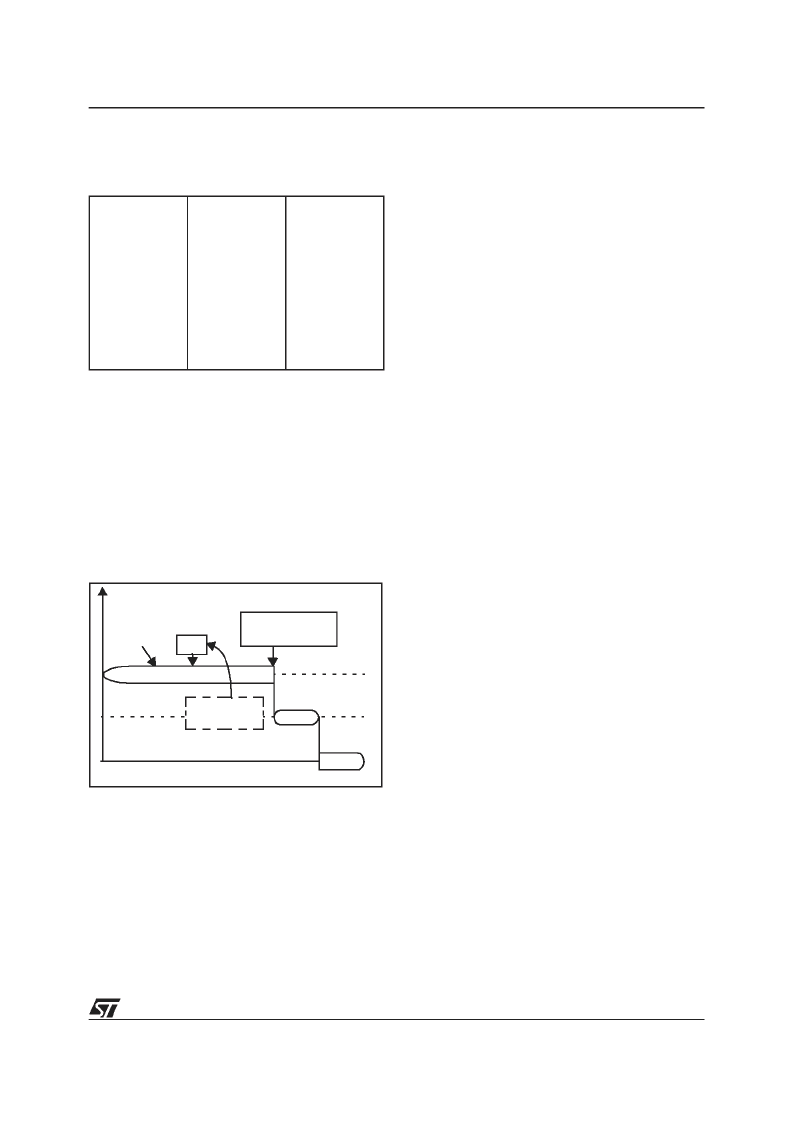- 您现在的位置:买卖IC网 > PDF目录380730 > ST92163N4G0 (意法半导体) 8/16-BIT FULL SPEED USB MCU FOR COMPOSITE DEVICES WITH 16 ENDPOINTS, 20K ROM, 2K RAM, I2C, SCI, & MFT PDF资料下载
参数资料
| 型号: | ST92163N4G0 |
| 厂商: | 意法半导体 |
| 英文描述: | 8/16-BIT FULL SPEED USB MCU FOR COMPOSITE DEVICES WITH 16 ENDPOINTS, 20K ROM, 2K RAM, I2C, SCI, & MFT |
| 中文描述: | 16位产品全速USB微控制器16端点,20,000光盘和2K的RAM,I2C和脊髓损伤的复合设备, |
| 文件页数: | 49/224页 |
| 文件大小: | 1372K |
| 代理商: | ST92163N4G0 |
第1页第2页第3页第4页第5页第6页第7页第8页第9页第10页第11页第12页第13页第14页第15页第16页第17页第18页第19页第20页第21页第22页第23页第24页第25页第26页第27页第28页第29页第30页第31页第32页第33页第34页第35页第36页第37页第38页第39页第40页第41页第42页第43页第44页第45页第46页第47页第48页当前第49页第50页第51页第52页第53页第54页第55页第56页第57页第58页第59页第60页第61页第62页第63页第64页第65页第66页第67页第68页第69页第70页第71页第72页第73页第74页第75页第76页第77页第78页第79页第80页第81页第82页第83页第84页第85页第86页第87页第88页第89页第90页第91页第92页第93页第94页第95页第96页第97页第98页第99页第100页第101页第102页第103页第104页第105页第106页第107页第108页第109页第110页第111页第112页第113页第114页第115页第116页第117页第118页第119页第120页第121页第122页第123页第124页第125页第126页第127页第128页第129页第130页第131页第132页第133页第134页第135页第136页第137页第138页第139页第140页第141页第142页第143页第144页第145页第146页第147页第148页第149页第150页第151页第152页第153页第154页第155页第156页第157页第158页第159页第160页第161页第162页第163页第164页第165页第166页第167页第168页第169页第170页第171页第172页第173页第174页第175页第176页第177页第178页第179页第180页第181页第182页第183页第184页第185页第186页第187页第188页第189页第190页第191页第192页第193页第194页第195页第196页第197页第198页第199页第200页第201页第202页第203页第204页第205页第206页第207页第208页第209页第210页第211页第212页第213页第214页第215页第216页第217页第218页第219页第220页第221页第222页第223页第224页

49/224
ST92163 - INTERRUPTS
with the highest position in the chain, as shown in
Table 10.
Table 10. Daisy Chain Priority
3.4.4 Dynamic Priority Level Modification
The main program and routines can bespecifically
prioritized. Since the CPL is represented by 3 bits
in a read/write register, it is possible to modify dy-
namically the current priority value during program
execution. This means that a critical section can
have a higher priority with respect to other inter-
rupt requests. Furthermore it is possible to priori-
tize even the Main Program execution by modify-
ing the CPL during its execution. See Figure 21
Figure 21. Example of Dynamic priority
level modification in NestedMode
INTERRUPT 6 HAS PRIORITY LEVEL 6
3.5 ARBITRATION MODES
The ST9 provides two interrupt arbitration modes:
Concurrent mode and Nested mode. Concurrent
mode is the standard interrupt arbitration mode.
Nested mode improves the effective interrupt re-
sponse time when service routine nesting is re-
quired, depending on the request priority levels.
The IAM control bit in the CICR Register selects
Concurrent Arbitration mode or Nested Arbitration
Mode.
3.5.1 Concurrent Mode
This mode is selected when the IAM bit is cleared
(reset condition). The arbitration phase, performed
during every instruction, selects the request with
the highest priority level. The CPL value is not
modified in this mode.
Start of Interrupt Routine
The interrupt cycle performs the following steps:
– All maskable interrupt requests are disabled by
clearing CICR.IEN.
– The PC low byte is pushed onto system stack.
– The PC high byte is pushed onto system stack.
– If ENCSR is set, CSR is pushed onto system
stack.
– The Flag register is pushed onto system stack.
– The PC is loaded with the 16-bitvector stored in
the Vector Table, pointed to by the IVR.
– If ENCSR is set, CSR is loaded with ISR con-
tents; otherwiseISR isused inplaceof CSRuntil
iret
instruction.
End of Interrupt Routine
The Interrupt Service Routine must be ended with
the
iret
instruction. The
iret
instruction exe-
cutes the following operations:
– The Flag register is popped from system stack.
– If ENCSR is set, CSR is popped from system
stack.
– The PC high byte is popped from system stack.
– The PC low byte is popped from system stack.
– All unmasked Interrupts are enabled by setting
the CICR.IEN bit.
– If ENCSR is reset, CSR is used instead of ISR.
Normal program execution thus resumesat the in-
terrupted instruction. All pending interrupts remain
pending until the next
ei
instruction (even if it is
executed during the interrupt service routine).
Note
: In Concurrent mode, the sourcepriority level
is only useful during thearbitration phase, where it
is compared with all other priority levels and with
the CPL. No trace is kept of its value during the
ISR. If other requests are issued during the inter-
rupt service routine, once the global CICR.IEN is
re-enabled, they will be acknowledged regardless
of the interrupt service routine’s priority. This may
cause undesirable interrupt response sequences.
Highest Position
Lowest Position
INTA0
INTA1
INTB0
INTB1
INTC0
INTC1
INTD0
INTD1
USB
MFT
SCI
I2C
INT0/WDT
INT1/ADC
INT2
INT3
INT4/
INT5
INT6/RCCU
INT7/WKUP
6
5
4
7
Priority Level
MAIN
CPL is set to 5
CPL=7
MAIN
INT 6
CPL=6
INT6
ei
CPL is set to 7
by MAIN program
CPL6 > CPL5:
INT6 pending
相关PDF资料 |
PDF描述 |
|---|---|
| ST92163N4G0V | 8/16-BIT FULL SPEED USB MCU FOR COMPOSITE DEVICES WITH 16 ENDPOINTS, 20K ROM, 2K RAM, I2C, SCI, & MFT |
| ST92163R4G0V | 8/16-BIT FULL SPEED USB MCU FOR COMPOSITE DEVICES WITH 16 ENDPOINTS, 20K ROM, 2K RAM, I2C, SCI, & MFT |
| ST92163R4T1V | 8/16-BIT FULL SPEED USB MCU FOR COMPOSITE DEVICES WITH 16 ENDPOINTS, 20K ROM, 2K RAM, I2C, SCI, & MFT |
| ST92E163R4T1V | 8/16-BIT FULL SPEED USB MCU FOR COMPOSITE DEVICES WITH 16 ENDPOINTS, 20K ROM, 2K RAM, I2C, SCI, & MFT |
| ST92T163R4T1V | 8/16-BIT FULL SPEED USB MCU FOR COMPOSITE DEVICES WITH 16 ENDPOINTS, 20K ROM, 2K RAM, I2C, SCI, & MFT |
相关代理商/技术参数 |
参数描述 |
|---|---|
| ST92163N4G0E | 制造商:STMICROELECTRONICS 制造商全称:STMicroelectronics 功能描述:8/16-BIT FULL SPEED USB MCU FOR COMPOSITE DEVICES WITH 16 ENDPOINTS, 20K ROM, 2K RAM, I2C, SCI, & MFT |
| ST92163N4G0L | 制造商:STMICROELECTRONICS 制造商全称:STMicroelectronics 功能描述:8/16-BIT FULL SPEED USB MCU FOR COMPOSITE DEVICES WITH 16 ENDPOINTS, 20K ROM, 2K RAM, I2C, SCI, & MFT |
| ST92163N4G0V | 制造商:STMICROELECTRONICS 制造商全称:STMicroelectronics 功能描述:8/16-BIT FULL SPEED USB MCU FOR COMPOSITE DEVICES WITH 16 ENDPOINTS, 20K ROM, 2K RAM, I2C, SCI, & MFT |
| ST92163N4G1 | 制造商:STMICROELECTRONICS 制造商全称:STMicroelectronics 功能描述:8/16-BIT FULL SPEED USB MCU FOR COMPOSITE DEVICES WITH 16 ENDPOINTS, 20K ROM, 2K RAM, I2C, SCI, & MFT |
| ST92163N4G1E | 制造商:STMICROELECTRONICS 制造商全称:STMicroelectronics 功能描述:8/16-BIT FULL SPEED USB MCU FOR COMPOSITE DEVICES WITH 16 ENDPOINTS, 20K ROM, 2K RAM, I2C, SCI, & MFT |
发布紧急采购,3分钟左右您将得到回复。